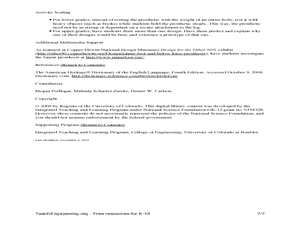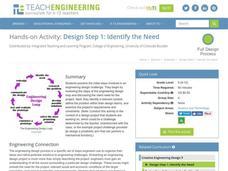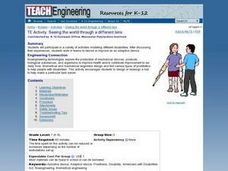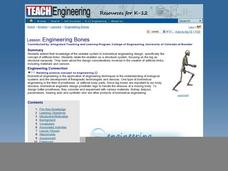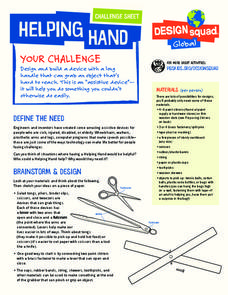Curated OER
Build a Prosthetic Device
Seventh graders become familiar with biomedical engineering. For this prosthetic device lesson, 7th graders consider the needs of a prosthetic device to help a specific person's characteristics. Students build a prosthetic...
Purdue University
Model of Prosthetic Leg
Give the class a leg up in their understanding of engineering. A STEM activity has learners design a prosthetic leg that can kick a ball. They build a prototype of the prosthetic, keeping track of the design costs associated with their...
Curated OER
Prosthetic Party
Students examine human anatomy by creating a prosthetic limb. In this medical engineering lesson, students view numerous images of prosthetics used in science today and define several medical terms associated with prosthetics....
Teach Engineering
Design Step 1: Identify the Need
What exactly does an engineer do? Learners find out through a instructional activity that asks them to solve a problem that affects a target population. Aspiring engineers learn the steps of the engineering design process...
Curated OER
Technology: Biomedical Engineering
Students participate in activities simulating various disabilities. After discussions, they work in teams to devise or improve on adaptive devices for people with disabilities. They include drawings of the tools they design and explain...
Curated OER
Engineering Bones
Pupils identify the features of a prosthetic limb and explain how engineers are involved in the prosthetic design. For this bone engineering lesson students describe the design criteria that goes into choosing the materials that go...
Curated OER
Medical Instrumentation
Students analyze how medical devices that help the human body function. They work in pairs or groups to draw multiple views of the medical device and describe how engineering is used by biomedial engineers.
DiscoverE
A Leg to Stand On
Give your learners a leg up in their study of engineering. Groups design and create a prothestic for a leg. They test out their designs for strength, stability, durability, and comfort.
Teach Engineering
Automatic Floor Cleaner Computer Program Challenge
Have your class use the engineering design process to program a vacuum robot. Using computer engineering concepts, teams program an automatic floor cleaner to traverse designated patterns.
Teach Engineering
Off-Road Wheelchair Challenge
Challenge your class to use their understanding of the engineering design process to design and build a small-scale, off-road prototype for an assistive technology device. Teams select materials to build their scale models, and, using...
Teach Engineering
Design Step 2: Research the Problem
How do you get started designing a product to meet your engineering design goals? Here, learners gain understanding of an important aspect of the engineering design process: background research. Through brainstorming and worksheets,...
Institute of Electrical and Electronics Engineers
Adaptive Device Design
After reading about how engineering has made adaptive devices possible for people with disabilities, pupils work in groups to discuss different devices to determine whether or not they are adaptive. They also disassemble a pair of...
Teach Engineering
Tissue Mechanics
Engage your class by showing them how silly putty and human tissues are alike. Pupils learn more about tissue mechanics by reflecting upon their experiences with silly putty. The lesson covers collagen, elastin, and...
DiscoverE
Helping Hand
Sometimes we all need a helping hand. Scholars get together to lend a hand in creating an assistive device that must be able to grab a hard-to-reach object. Now that's some help we could all use!
Curated OER
Muscles, Oh My!
Pupils explore the human muscular system. For this science lesson, students discuss how engineering is related to the field of bio-mechanics and human movement.
PBS
Helping Hand
Reach out and grab something. Given the task of picking up objects at least two feet away, pupils design and build a grabber. The last activity in a series of five challenges requires learners to use information about fulcrums and levers.
Curated OER
No Valve in Vain
Students design and create their own heart valves out of a variety of materials. Their heart valves are one way valves designed for water flowing through a tube representing blood moving through the heart.
Curated OER
Science: Put Your Heart into Engineering
Students examine the heart and vascular system and the need for artificial valves. After explaining how heart valves function, they design their own heart valves for experimentation. They predict the speed of fluid flowing through...
Curated OER
Able Sports
Students work together to design a new sport for disabled persons. They share their new sport with the class. They discover how mechanical and biomedical engineers use information to test prosthetics.
Rochester Institute of Technology
Biomechanical Joint
Discuss mechanical advantage and how the human body moves/works. Learners focus on bioengineering, working together to build a functioning mechanical arm. Additionally, they analyze an air muscle, discussing its appropriate use in...
Curated OER
Silly Semi-Solids
Students create a polymer out of glue, water, and borax. They discuss the resulting substance and perform several experiments with it.
Teach Engineering
Connect the Dots: Isometric Drawing and Coded Plans
Individuals discover how to draw cubes on triangle-dot paper. They use cubes to build structures and draw corresponding isometric drawings on dot paper in the second lesson of the series of five. The activity also introduces the concept...
Curated OER
Strong as the Weakest Link
Young scholars recognize that compression and tension forces are important considerations in building structures. They construct their own building structure using marshmellows and spaghetti to see which structure can hold the most weight.
Curated OER
Digestion Simulation
Students study the human digestion system and the functions of the stomach and small intestines. In this digestion instructional activity students view a demonstration on the process.




